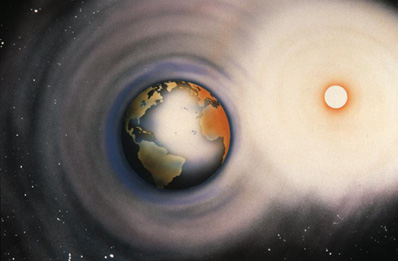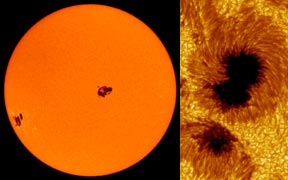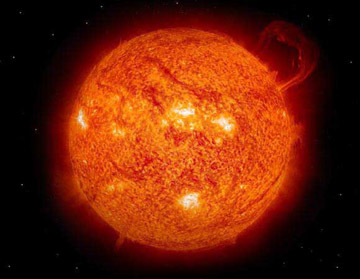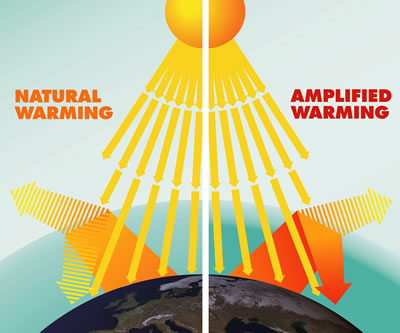Click on image for full size
Courtesy of UCAR
Solar Cycle Variations and Effect on Earth's Climate
Is it possible that the "solar constant" isn't so constant after all? For more than 100 years, scientists have wondered if cycles on the Sun and changes of the solar irradiance or energy received at Earth because of those cycles affect weather or global climate on Earth. It is now thought that the solar cycles on the Sun don't affect weather, but that they do have a very slight effect on global climate (but nowhere nearly enough to explain recent global warming).The most well known solar cycle, the rise and fall of the number of sunspots on the Sun, has been known since the mid-19th century. This solar cycle goes from when the Sun has a minimum number of sunspots (a solar minimum) to when the Sun has a maximum number of sunspots (a solar maximum) back to a minimum. The time between two minimums is about 10.5 to 11 years. Solar activity is related to the solar cycle. Because solar activity (such as coronal mass ejections) is more frequent at solar maximum and less frequent at solar minimum, geomagnetic activity also follows the solar cycle.
Energy output from the Sun, or irradiance, changes as the sunspot count on the Sun changes. It is greatest when there are the most sunspots and lowest when there are the least sunspots. With the recent ability to use satellite measurements, especially radiometer measurements, scientists have been able to confirm that the total solar irradiance varies 0.1% over one 11-year sunspot cycle. This variation of 0.1% translates to a global tropospheric temperature difference of 0.5oC to 1.0oC (1). The irradiance specifically at higher wavelengths changes even more drastically (this affects 14C production on Earth). These facts definitely have to be taken into account when dealing with climate models and predictions.
One possible example of the connection between the solar cycle and Earth's climate is the Maunder Minimum. This was the largest well-documented disruption in sunspots observed in the historic period, lasting from about 1645 to 1715. During this time almost no sunspots were seen. Europe and parts of North America were struck by spells of remarkably cold weather at roughly the same time. A period of cooler climate called the Little Ice Age extended from around 1350 to 1850, and some of its coldest periods roughly coincide with the times of decreased solar activity during the Maunder Minimum. Scientist are uncertain precisely what link, if any, might exist between the altered behavior of the Sun and the disruption of Earth's climate. There is also considerable debate as to the geographical extent of the Little Ice Age; some scientists think it was a worldwide phenomenon, while others think its effects were felt mainly in Europe and some parts of North America.
"It might be argued that if you look hard enough, you can find a correlation between solar cycles and anything, such as cycles in the stockmarket." (1) There does seem to be a connection between the solar cycle and climate - the very small change in solar irradiance that occurs over the solar cycle seems to have a very small impact on Earth's climate (see IPCC report). Modern climate models take these relationships into account. The changes in solar irradiance are not big enough, however, to cause the large global temperature changes we've seen in the last 100 years. Indeed, the only way that climate models can match the observed warming of the atmosphere is with the addition of greenhouse gases.















